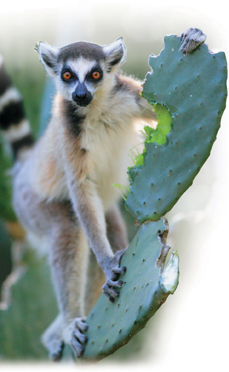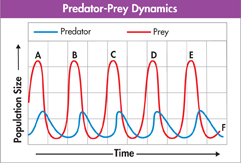Predation, Herbivory, and Keystone Species
 How do predation and herbivory shape communities?
How do predation and herbivory shape communities?
Virtually all animals, because they are not primary producers, must eat other organisms to obtain energy and nutrients. Yet if a group of animals devours all available food in the area, they will no longer have anything to eat! That's why predator-prey and herbivore-plant interactions are very important in shaping communities.
Predator-Prey Relationships An interaction in which one animal (the predator) captures and feeds on another animal (the prey) is called predation (pree DAY shun).  Predators can affect the size of prey populations in a community and determine the places prey can live and feed. Birds of prey, for example, can play an important role in regulating the population sizes of mice, voles, and other small mammals.
Predators can affect the size of prey populations in a community and determine the places prey can live and feed. Birds of prey, for example, can play an important role in regulating the population sizes of mice, voles, and other small mammals.
Herbivore-Plant Relationships Interactions between herbivores and plants, like the one shown in Figure 4 –8, are as important as interactions between predators and prey. An interaction in which one animal (the herbivore) feeds on producers (such as plants) is called herbivory.  Herbivores can affect both the size and distribution of plant populations in a community and determine the places that certain plants can survive and grow. Herbivores ranging from caterpillars to elk can have major effects on plant survival. For example, very dense populations of white-tailed deer are eliminating their favorite food plants from many places across the United States.
Herbivores can affect both the size and distribution of plant populations in a community and determine the places that certain plants can survive and grow. Herbivores ranging from caterpillars to elk can have major effects on plant survival. For example, very dense populations of white-tailed deer are eliminating their favorite food plants from many places across the United States.

FIGURE 4–8 Herbivory The ring-tailed lemur is an herbivore—meaning that it obtains its energy and nutrients from plants like the cactus it's eating here.
Analyzing Data
Predator-Prey Dynamics
The relationships between predator and prey are often tightly intertwined, particularly in an environment in which each prey has a single predator and vice versa. The graph here shows an idealized computer model of changes in predator and prey populations over time.
Predict Suppose a bacterial infection kills off most of the prey at point B on the graph. How would this affect the predator and prey growth curves at point C? At point D?
Predict Suppose a sudden extended cold spell destroys almost the entire predator population at point F on the graph. How would the next cycle of the prey population appear on the graph?
Relate Cause and Effect Suppose a viral infection kills all the prey at point D on the graph. What effect would this have on the predator and prey growth curves at point E? What will happen in future years to the predator population? How could ecologists ensure the continued survival of the predators in this ecosystem?
Table of Contents
- Formulas and Equations
- Applying Formulas and Equations
- Mean, Median, and Mode
- Estimation
- Using Measurements in Calculations
- Effects of Measurement Errors
- Accuracy
- Precision
- Comparing Accuracy and Precision
- Significant Figures
- Calculating With Significant Figures
- Scientific Notation
- Calculating With Scientific Notation
- Dimensional Analysis
- Applying Dimensional Analysis





